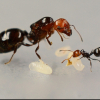Better up close pics
- Formiculture.com
- Forums
- Gallery
- Members
- Member Map
- Chat

OK, that is a Camponotus (Myrmentoma) queen, and a completely different ant than the ones pictured beforehand. This is probably Camponotus hyatti.
Hi there! I went on a 6 month or so hiatus, in part due, and in part cause of the death of my colonies.
However, I went back to the Sierras, and restarted my collection, which is now as follows:
Aphaenogaster uinta, Camponotus vicinus, Camponotus modoc, Formica cf. aserva, Formica cf. micropthalma, Formica cf. manni, Formica subpolita, Formica cf. subaenescens, Lasius americanus, Manica invidia, Pogonomyrmex salinus, Pogonomyrmex sp. 1, Solenopsis validiuscula, & Solenopsis sp. 3 (new Sierra variant).
So I have Camponotus hyatti, Camponotus (Myrmentoma) queen, and Camponotus nearcticus as different species people think this ant is. Anyone have any idea which one of these species this queen is? And all the pictures are of the same ant (excluding the first five pictures I posted).
Edited by antboyidaho, May 19 2021 - 4:42 PM.
Colonies:
One Formica Podzolica queen in a test tube setup.
Well nearcticus and hyatti are two myrmentoma species.So I have Camponotus hyatti, Camponotus (Myrmentoma) queen, and Camponotus nearcticus as different species people think this ant is. Anyone have any idea which one of these species this queen is? And all the pictures are of the same ant (excluding the first three pictures I posted).
Can someone explain where Myrmentoma fits into the Camponotus genus?
Colonies:
One Formica Podzolica queen in a test tube setup.
Myrmentoma is a subgenus of Camponotus. Myself, and others, often refer to these ants by their subgenus, as it makes it clearer what you are talking about. This is likely hyatti, they are more common in Idaho, and the west in general, from what I gather, and, you pretty much do not see nearcticus in this color pattern.
Hi there! I went on a 6 month or so hiatus, in part due, and in part cause of the death of my colonies.
However, I went back to the Sierras, and restarted my collection, which is now as follows:
Aphaenogaster uinta, Camponotus vicinus, Camponotus modoc, Formica cf. aserva, Formica cf. micropthalma, Formica cf. manni, Formica subpolita, Formica cf. subaenescens, Lasius americanus, Manica invidia, Pogonomyrmex salinus, Pogonomyrmex sp. 1, Solenopsis validiuscula, & Solenopsis sp. 3 (new Sierra variant).
So from my understanding the subgenus Myrmentoma is a group of Camponotus that are smaller than other Camponotus sp.?
Edited by antboyidaho, May 19 2021 - 5:14 PM.
Colonies:
One Formica Podzolica queen in a test tube setup.
There are other distinguishing features, but they are generally smaller than other North American species, yes. I'm sure you can read about it on antwiki. And this is most likely hyatti, not nearcticus, as I have said previously, despite what was said on the other thread.
Hi there! I went on a 6 month or so hiatus, in part due, and in part cause of the death of my colonies.
However, I went back to the Sierras, and restarted my collection, which is now as follows:
Aphaenogaster uinta, Camponotus vicinus, Camponotus modoc, Formica cf. aserva, Formica cf. micropthalma, Formica cf. manni, Formica subpolita, Formica cf. subaenescens, Lasius americanus, Manica invidia, Pogonomyrmex salinus, Pogonomyrmex sp. 1, Solenopsis validiuscula, & Solenopsis sp. 3 (new Sierra variant).
0 members, 0 guests, 0 anonymous users